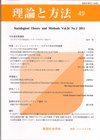Volume 27, Issue 2
Displaying 1-9 of 9 articles from this issue
- |<
- <
- 1
- >
- >|
Special Issue:
-
2012Volume 27Issue 2 Pages 201-204
Published: 2012
Released on J-STAGE: August 12, 2013
Download PDF (117K) -
2012Volume 27Issue 2 Pages 205-224
Published: 2012
Released on J-STAGE: August 12, 2013
Download PDF (314K) -
2012Volume 27Issue 2 Pages 225-242
Published: 2012
Released on J-STAGE: August 12, 2013
Download PDF (488K) -
2012Volume 27Issue 2 Pages 243-258
Published: 2012
Released on J-STAGE: August 12, 2013
Download PDF (765K) -
2012Volume 27Issue 2 Pages 259-276
Published: 2012
Released on J-STAGE: August 12, 2013
Download PDF (354K)
Articles
-
2012Volume 27Issue 2 Pages 277-298
Published: 2012
Released on J-STAGE: August 12, 2013
Download PDF (314K)
Research Note
-
2012Volume 27Issue 2 Pages 299-306
Published: 2012
Released on J-STAGE: August 12, 2013
Download PDF (102K)
Seminar: Methods of Mathematical Sociology (5)
-
2012Volume 27Issue 2 Pages 307-312
Published: 2012
Released on J-STAGE: August 12, 2013
Download PDF (308K)
Book Reviews
-
2012Volume 27Issue 2 Pages 313-324
Published: 2012
Released on J-STAGE: August 12, 2013
Download PDF (386K)
- |<
- <
- 1
- >
- >|
